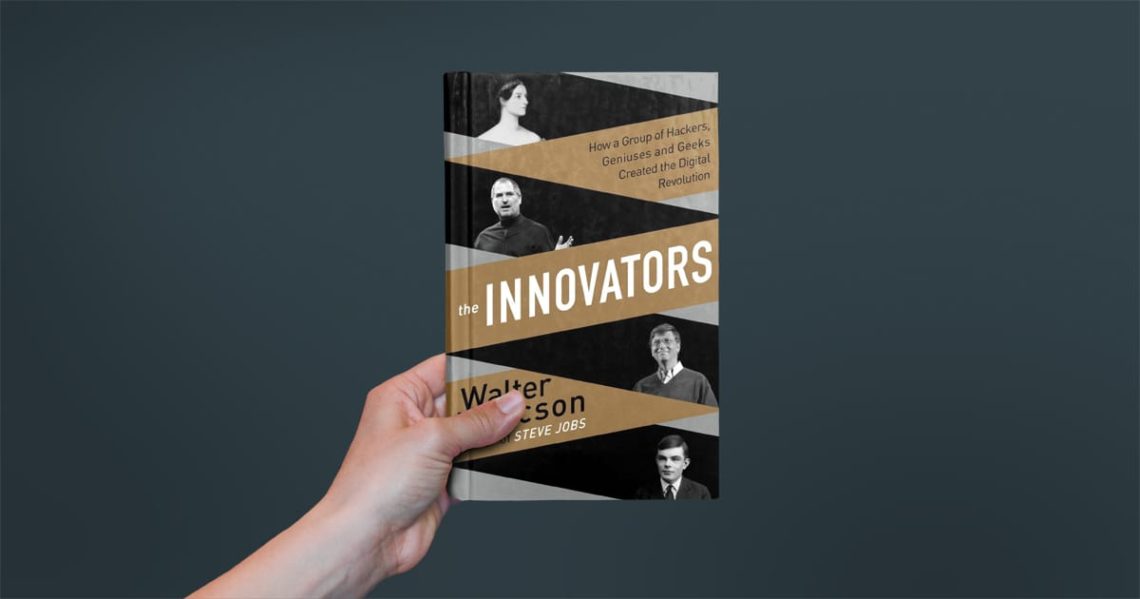The Innovators is a book by Walter Isaacson that goes through the life and achievements of the minds that are responsible for the current state of modern computers and internet. The book has some quite interesting stories, although it tends to be a bit dense in some fragments.
It won’t become one of my favorite books by a long shot, but nevertheless I’m glad I read it. I got to learn some things that I didn’t know before, so for that I’m grateful.
Here are the notes I took while reading the book. They are not in any particular order or connected in any particular way. This isn’t supposed to be a summary, review or essay. It may even have some key information or examples missing. They are just thoughts and direct quotes that caught my attention and I felt like marking or writing down to try to retain them in my memory.
When it comes to innovation, there’s a mix of individual, social, cultural and historical forces that come into play.
The collaboration that the digital era allowed, is not only between colleagues, but also between different generations and even machines.
Ada Lovelace is the mother of the concept of computers and the representation and manipulation of different all types of information as symbols (for example, numbers). She also conceptualized sub-routines, loops and conditional jumps.
Innovation is not only about great leaps and big achievements, it’s also about the little steps forwards. Both are equally necessary.
Modern informatics have the following properties:
- It’s digital, as opposed to analog.
- It’s binary, which makes simple at the core.
- It’s electronic, which makes it fast.
- It’s universal (re-programmable).
There’s a very blurred line that separates initiative and disobedience.
Great ideas aren’t worth much if they are not properly executed.
Grace Hopper perfected sub-routines and conceptualized the compiler.
Genius minds are able to deconstruct the most complex problems to their most basics aspects.
Turing was the most passionate exponent that machines were able to think.
Technology turns industrial devices into personal ones.
To keep a successful group close, a special type of leader is needed:
- Inspiring and stimulating.
- Competitive and collaborative.
- He/She has to instil a non-hierarchical mentality.
A useful trait on leader is to know when to turn their backs on the skeptics and when to listen to their critics and what they have to say.
The difference between geniuses and stupid people is who ends up being right or whose ideas turn out to be accurate.
Noyce and Kirby are the microchip inventors.
Un key aspect of innovation is to invent new devices, where other key aspect is to find new ways to use said devices.
Moore’s law: the amount of transistors (ergo, processing power) of a device is duplicated every two years.
Murphy’s law: if something can go wrong, it will go wrong. (I always get both concepts mixed up)
Ockham razor: usually, the simplest solution is the best solution.
On of Arthur’s Rock (investor) maxims was to bet on more on the people instead of just their ideas.
Noyce and Moore: Intel founders.
Inventions happen when a problem arises and a great amount of effort is put into solving it, or when someone/some people impose on themselves a visionary objective.
Intel (Hoff) are the one who invented microprocessors.
Video games were one of the main drivers for personal computers, and the ideas of real time interaction, intuitive interfaces and nice graphics.
Hack: something that has a brilliant result, but it’s done quickly and without elegance.
Spacewar was the first video game (1962). It positioned the aspects that are at the core of the digital community nowadays: collaboration, open source software, and personal and interactive computers.
Pong was developed by Atari on 1972.
Innovations need at least:
- A great idea.
- The technical talent to bring it to life.
- The business experience to make it a success.
- The cold blood needed to close business deals.
Nolan Bushnell, Atari’s founder, is considered to be the father of video games.
Internet was invented by an alliance between the private sector, universities and the military.
Licklider can be considered one of the fathers of the internet. Bob Taylor was the one who first conceptualized it (ARPANET: equipment and data connected between universities and research centers). Larry Roberts was the architect.
Circuit switching: a communication circuit is opened between two nodes, and information flows constantly.
Message switching: the message has a header with the recipient address, it’s delivered to the network and then transmitted.
Packet switching: the message is divided in packets of the same size. The header now includes the packet order apart from the recipient address. The packet now “jumps” from node to node in the network, which allows different packets to follow different “paths”, and they are organized when they arrive to their destination.
Baran, Davis, and Kleinrock (although there seems to be some controversy regarding the last one) are the ones who thought of the last concept, which is the one that is mostly used in modern telecommunications.
Metcalf created Ethernet to connect the different computers of Xerox Parc research center.
Kahn and Cerf were the ones tasked with creating the protocol which would allow different independent networks to create connections between them, which could be considered how Internet came to life. To do so, they invented the TCP/IP protocol.
Computers have done more to change society than politics.
Engelbart was the creator of the “mouse” and the one who conceptualized the utility modern computers could have, by creating a dummy terminal that resembled a personal computar, but was remotely connected to a mainframe.
The best way to predict the future is to create it.
Devices shouldn’t need instruction manuals. They should be simple and intuitive; and so should interfaces.
Pretend to be completely in control and people will assume that you are.
Steve Wozniak is credited for creating the first personal computer that had a keyboard, a screen and a processing unit for amateurs and enthusiasts.
Steve Jobs was the one behind idea of the commercialization of already-assembled computers.
The Apple GUI was based on Xerox work. The first computers with a tradition GUI were Lisa (1983) and Macintosh (1984).
Stallman was the creator of GNU, GNU Public License and Copyleft (which allows for free usage, modification and distribution as long as you don’t add restrictions to its use).
Linus Torvalds is Linux’ creator.
When enough eyes are looking at something, there’s no chance an error can slip by.
Innovation flowers where the conditions and context are adequate. New ideas are originates when a multitud of casual concepts fit together until they merge in something new.
Tim Berners-Lee was the practical creator of hypertext in the internet, which lead to URLs as we know them today. He also created the http protocol and HTML.
Alongside Cailleau, they were the project leaders of the World Wide Web at CERN.
We need to cultivate a healthy indifference for the impossible. We should try to do things that no one would dare to do.
The human-machine symbiosis proposes that they should complement each other as opposed of the concept that machines should replace humans entirely.
The first generation of computers where calculators and tabulators. The second generation was about programmable computers that followed instructions. And the third generation of computers are the ones that “learn”.
Visions without execution are nothing but hallucinations.





Comments by Nacho